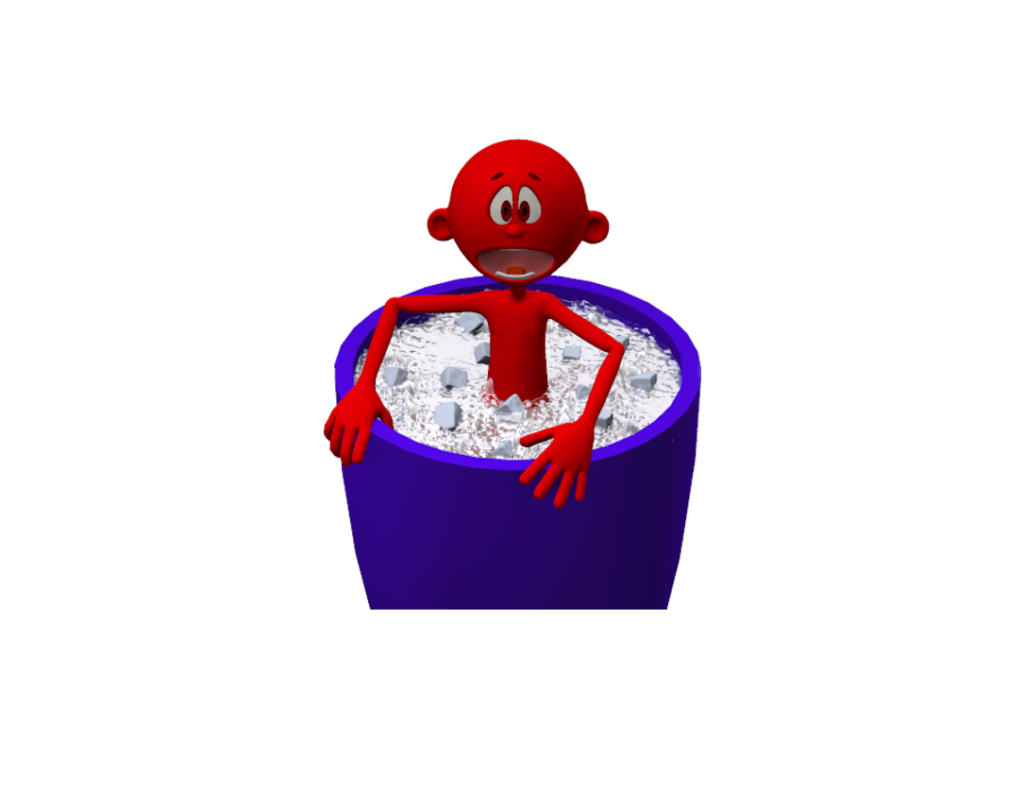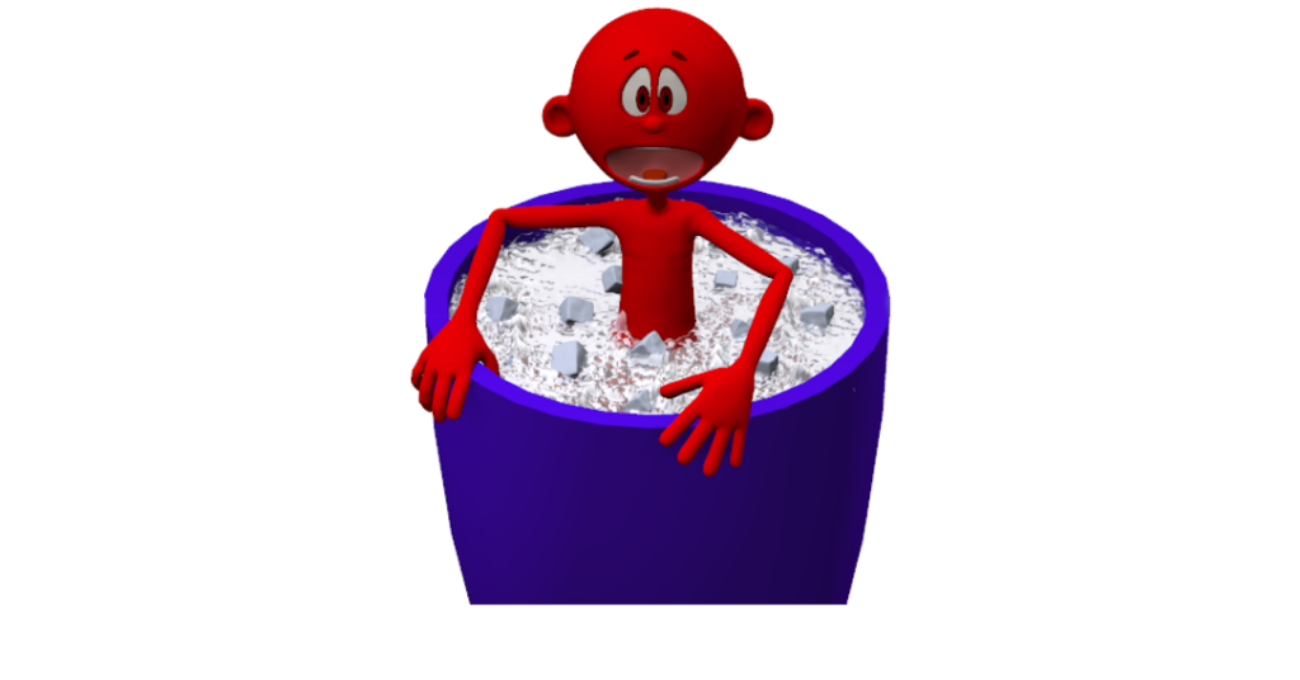Cold gets iced
The magic sponge
Some of you (actually probably very few now that I think about it) may remember when on-field injury treatment was a bucket of water and a sponge. It was a bit of a standing joke in sport, probably because it appeared to miraculously work 99% of the time – hence the term ‘magic sponge’ (look it up – it will be in the urban dictionary). Getting the wet sponge out to the injured player was the job of the local St John’s Ambulance volunteer (we called them Zambucks – I’ve no idea why!) who attended all sports events in those days, and tended to be the sole medical help. This turned out to be part of the crowd entertainment, as the Zambucks were not well suited to running with buckets of water (uniform and equipment wise, or fitness wise). Apologies for the momentary lapse in repect – Zambucks were great volunteers who treated me often – so a belated thanks!
The ice age
Around the middle of the 1970s, cold became the preferred first aid treatment for athletic injuries, with cold sprays and ice bags making on-field and on-court appearances. The acronym R.I.C.E. found its way into sports jargon somewhere in the mid–1970s, supported by extensive education programmes to convince injured athletes and exercisers to rest, apply ice and compression and elevate injured body parts. This ‘new thinking’ took some accepting and adjustment as the popular treatment at the time was applying heat and ‘rubbing’ fresh injuries. My master’s research at the University of Alberta in the early 1980s explored muscle blood flow changes with cold application – wow, that was almost cutting edge back then! Of course, RICE became an accepted part of sport and exercise participation, with Prevention and Diagnosis being added to give us PRICED as the chosen acronym. Most of those involved with sports would be well aware of this recommendation for the intitial management of injuries.
Cold everywhere
As long as it has taken to educate the general public on how to best provide primary care for sports injuries, it now seems that some of that wisdom is being reconsidered and challenged. In contemporary sports, cold is employed in a number of ways. First and foremost it is used in the primary care of musculoskeletal injuries. New Zealand’s Accident Compensation Corporation states that ‘…the R.I.C.E.D. method of injury treatment can relieve pain, limit swelling and protect the injured tissue, all of which help to speed healing’. Aside from limiting the inflammatory responses, it was claimed that cold could also reduce the subsequent oxidative stress and possible ‘secondary damage’ to the surrounding tissues.
Cold has also been employed as a recovery modality with cold water immersion (CWI) suggested to help reduce pain and inflammation, alleviate delayed-onset muscle soreness, improve the rate of recovery of muscle power after exercise (Anderson et al 2018), and possibly counter some of the cardiovascular strain from exercise and speed recovery of autonomic nervous system function.
The combination of cold with heat (Contrast water therapy, CWT) is also used post- exercise in an attempt to hasten recovery. More recently extreme-cold, whole-body cryotherapy has been commercialised as a technique that claims to relieve pain, promote muscle healing and reduce inflammation (plus a long list of more dubious claims).
Wait, what?
The 10th man ponders these points and wonders…… it seems that there are two major assumptions underpinning contemporary cooling practices. The first assumption is that reducing inflammation and speeding up recovery is beneficial, and is the sort of thing that we should be seeking for our athletes. The second assumption is that cold actually does do what it is purported to do; that all of this sitting around shivering has some benefit.
Cold stocks plummet with recent research
A number of recent studies have started to chip away at those assumptions. Front and centre, has been work from the lab of Otago Phys. Ed. School alum, Jonathan Peake (BPhEd Hons, 1997; MPhEd, 2000) now working at Queensland University of Technology. In one study, Peake’s group found that CWI delayed or inhibited muscle satellite cell activity and suppressed pathways for muscle adaptation, in turn reducing gains in muscle mass and strength (Roberts et al, 2015). The authors concluded that cold water immersion intended to improve recovery, may actually be counterproductive for muscle adaptation and recovery – not really what the athletes lifting weights want to hear! In a follow-up study, Peake et al (2017) compared CWI with a traditional active recovery/warm down, finding that the responses of inflammatory markers were not substantially better with cold water immersion. This was the first evidence using human participants, that refuted the premise that post-exercise CWI helps moderate muscle inflammation and stress responses.
It needs to be acknowledged that some studies have found moderate benefits (e.g. Machado et al, 2016) from CWI, however evidence from the literature is inconsistent and although the practice remains popular, research support for cold therapy remains equivocal.
An Australian study found that while massage and stretching were preferred over cold water immersion as recovery modalities, CWI was still viewed as highly effective (Crowther et al, 2017). The authors noted that athletes’ perceptions don’t always correspond with scientific evidence. Using a convincing sham CWI treatment (liquid soap), Broatch et al (2014) demonstrated that placebo is a big part of CWI popularity. Performance recovery was identical for whether participants underwent true CWI or the sham treatment.
So what’s the harm?
Ok, so maybe cold doesn’t do those things it’s supposed to, and we’ve acknowledged the placebo effect – where’s the harm?
Well…..injured muscle has the ability to regenerate but depending on the injury severity, that healing process can be slow, and complete recovery can be impeded by the development of scar tissue (Sato, 2003). If damaged tissue was replaced with the same kind of normal cells repair would be optimal. However, as part of the remodeling process, damage tissued is often replaced temporarily by fibrous tissue that provides a scaffold or framework for subsequent repair. If the deposition of fibrous tissue is excessive (fibrosis or scarring) there is an excessive accumulation of extracellular matrix proteins, particularly collagen, which of course has neither elasticity nor contractile properties. Scarring, in this case, is non-functional tissue, and hinders full strength recovery in the injured muscle (Sato, 2003).
Chazaud (2016) argues that inflammation should not be considered as a bad or detrimental process. In fact, he claims that inflammation is essential for optimal muscle repair and complete functional recovery. With cold, the question is whether this modality not only masks pain perception but also adversely interferes with structural remodeling and functional recovery? Shibaguchi et al (2016) demonstrated that cold application following muscle injury accelerated and enhanced the development of fibrosis in muscle. Heat, however, inhibited fibrosis and contributed positively to muscle recovery. McGorm et al (2018) likewise suggest that heat supports muscle regeneration and restricts muscle atrophy and fibrosis.
Summary
While some of this recent research has methodological limitations (e.g. using animal models and non-strain injuries) there is enough ‘good stuff’ here to suggest that we should be asking questions about the ethics and sense of interfering with the ‘natural’ recovery and inflammatory processes through with the use of cold water immersion, cryotherapy (and other modalities such as non-steroidal anti-inflammatory medications). The 10th man does not like to think that in seeking to accelerate recovery to enable an athlete to train or play sooner than their body would normally permit, that we may also be contributing to their long-term suboptimal function (excess fibrosis/scarring) or predisposing them to further injury. It seems that quick may not necessarily be good.
There does not as yet seem to be any research on the value/harm of the immediate use of cold. The rest, compression and elevation all still seem to be important for initial management. But in the meantime, the next time the 10th man pulls a hammy or calf muscle, he will be applying cold until he can get to a heat source! Who knows in another few years that logic might all be turned around once again.
Best, Phil
Selected references
- Anderson, D, Nunn, J, and Tyler, CJ. Effect of cold (148 C) vs. ice (58 C) water immersion on recovery from intermittent running exercise. J Strength Cond Res 32(3): 764–771, 2018
- Broatch, J. R., A. Petersen, Bishop, D. J. ( 2014) Postexercise Cold Water Immersion Benefits Are Not Greater than the Placebo Effect. Med. Sci. Sports Exerc. 46(11) ;2139–2147.
- Chazaud, B. (2016) Inflammation during skeletal muscle regeneration and tissue remodeling: application to exercise-induced muscle damage management. Immunology and Cell Biology 94, 140–145; doi:10.1038/icb.2015.97
- Crowther, F. et al (2017) Team sport athletes’ perceptions and use of recovery strategies: a mixed-methods survey study. BMC Sports Science, Medicine and Rehabilitation 9(6) DOI 10.1186/s13102–017–0071–3.
- Machado, A.F. et al (2016) Can Water Temperature and Immersion Time Influence the Effect of Cold Water Immersion on Muscle Soreness? A Systematic Review and Meta-Analysis. Sports Med 46:503–514 DOI 10.1007/s40279–015–0431–7
- McGorm, H., Roberts, L.A. , Coombes, J.S., Peake, J.M. (2018) Turning Up the Heat: An Evaluation of the Evidence for Heating to Promote Exercise Recovery, Muscle Rehabilitation and Adaptation. Sports Med 48:1311–1328 https://doi.org/10.1007/s40279–018–0876–6
- Peake, J. M., et al (2017), The effects of cold water immersion and active recovery on inflammation and cell stress responses in human skeletal muscle after resistance exercise. J Physiol, 595: 695–711. doi:10.1113/JP272881
- Roberts, L.A. et al (2015) Post-exercise cold water immersion attenuates acute anabolic signalling and long-term adaptations in muscle to strength training. J Physiol 593(18); 4285–4301.
- Sato, K. et al (2003) Improvement Of Muscle Healing Through Enhancement Of Muscle Regeneration And Prevention Of Fibrosis. Muscle Nerve 28: 365–372. Shibaguchi, T. et al (2016) Effects of icing or heat stress on the induction of fibrosis and/or regeneration of injured rat soleus muscle. J Physiol Sci 66:345–357 DOI 10.1007/s12576–015–0433–0


Can we trust this? – The 10th Man
August 12, 2021 @ 6:17 am
[…] their guidelines. For example, New Zealand’s Accident Compensation Corporation still promotes cool down as part of injury prevention. While cooling down after activity is a nice habit to promote, […]